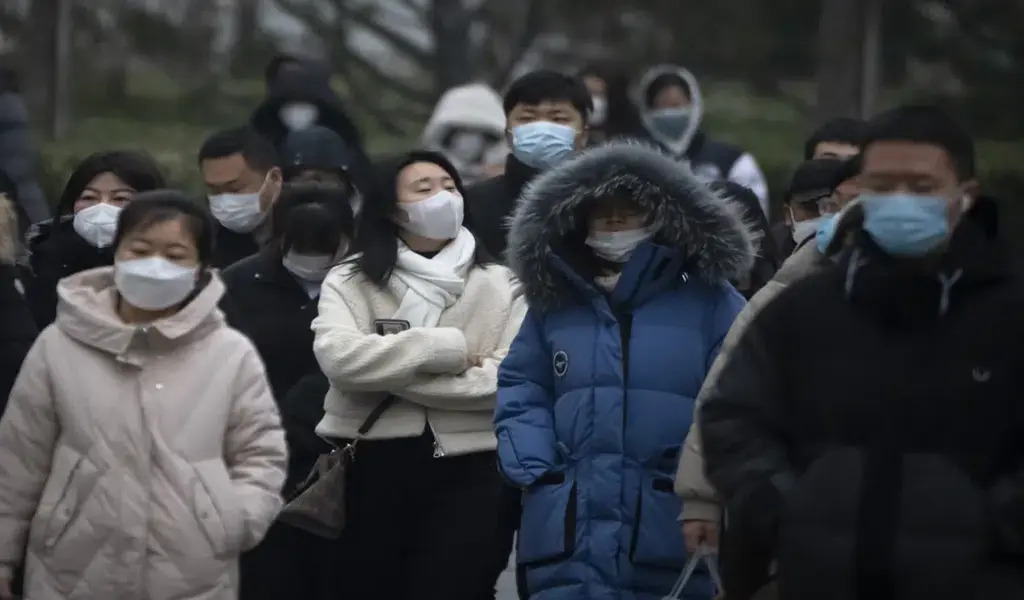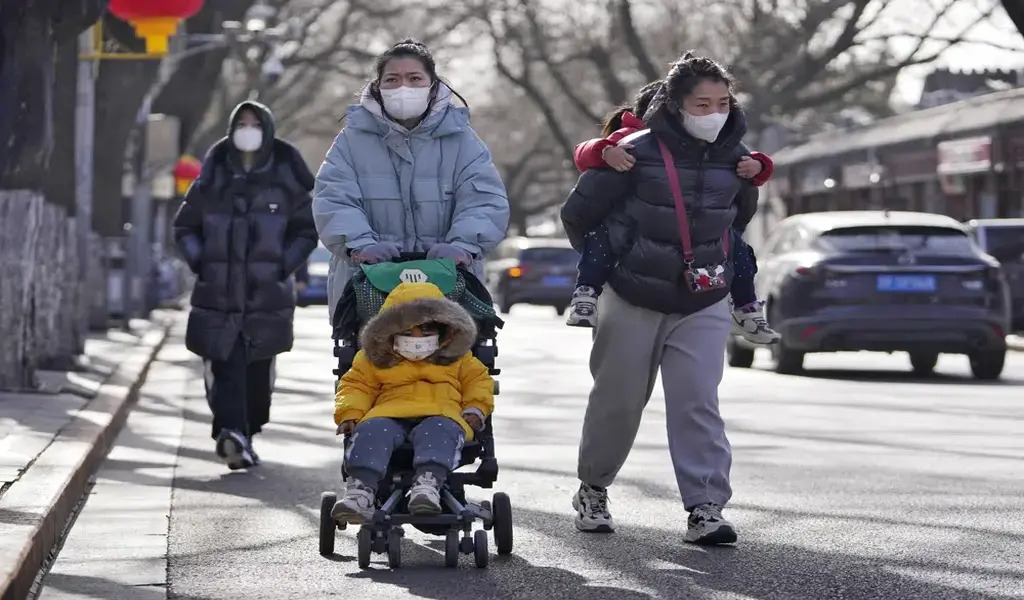News
China’s Population Plunges For The 1st Time Since 1961 As Births Drop

(CTN NEWS) – BEIJING – Official statistics released on Tuesday revealed that China’s population decreased for the first time in decades last year due to a sharp decline in the birthrate.
Adding to the strain on the country’s authorities to maintain economic growth despite an ageing labor force and mounting tensions with the United States.
Despite the official statistics, some experts think China’s population has been declining for a while. This would be a remarkable change for a nation that once attempted to regulate population growth by enforcing a one-child policy.
Many rich nations are grappling with how to deal with aging populations, which can hinder economic growth as dwindling workforces attempt to support rising older populations.

Commuters wearing face masks walk along a street in the central business district in Beijing on Jan. 12, 2023. China has announced its first overall population decline amid an aging society and plunging birthrate in recent years. (AP Photo/Mark Schiefelbein)
But a middle-income country like China, which lacks the means to care for an elderly population in the same way that a country like Japan does, would find it particularly challenging to handle the demographic transformation.
That might keep inflation higher in many developed economies over time and eventually slow its economy as well as the global one.
Yi Fuxian, a demographer and specialist in Chinese population trends at the University of Wisconsin-Madison, stated that China had aged before it had gotten wealthy.
If fewer chances fuel public unrest, a slowing economy might also be problematic politically for the Communist Party, which now holds power.
Late last year protests that sometimes demanded the resignation of leader Xi Jinping erupted out of resentment over the severe COVID-19 lockdowns, which were a drag on the economy and a rare frontal challenge to the party.

Women wearing face masks walk with their children on a street as they head to Forbidden City in Beijing, Tuesday, Jan. 17, 2023. China has announced its first population decline in decades as what has been the world’s most populous nation ages and its birthrate plunges. (AP Photo/Andy Wong)
According to data released on Tuesday by the National Bureau of Statistics, the country had 850,000 fewer citizens by the end of 2022 than the previous year. The total population of mainland China is included; Hong Kong, Macao, and international inhabitants are not included.
According to government statistics, there were over 1 million fewer births than the previous year due to the faltering economy and widespread pandemic lockdowns. 9.56 million babies were born in 2022, according to the agency, while 10.41 million people died.
Following the relaxation of pandemic restrictions last month, it remained unclear whether a large COVID-19 outbreak impacted the population statistics.
Since early December, China has claimed 60,000 COVID-related deaths, but some experts think the authorities likely underreport this number.
The Great Leap Forward, a disastrous campaign for collective farming and industrialization started by then-leader Mao Zedong at the end of the 1950s, is thought to have caused the last population decrease in China.
Which resulted in a massive famine that killed tens of millions of people.

Travelers walk through a trains departure board at the West Railway Station in Beijing on Jan. 15, 2023. China has announced its first overall population decline in recent years amid an aging society and plunging birthrate. (AP Photo/Andy Wong, File)
Yi, the demographer, claimed that China’s population loss has started nine to ten years earlier than official estimates and United Nations projections.
With 1.4 billion people, the country has held the title of the most populated country in the world for a while, but if it hasn’t already, India is predicted to overtake it soon.
China has worked to increase its population since the one-child ban was formally ended in 2016. Since then, with little success.
China has attempted to persuade people to have a second or even third child, following attitudes in much of east Asia where birth rates have sharply declined.
In China, the cost of raising kids in cities is frequently highlighted as a contributing factor.
Zhang Huimin lamented the “fierce rivalry” that young people nowadays face, which is a pretty normal perspective on having children among people in her age group.
The 23-year-old Beijing resident complained that it was difficult to obtain a job and that housing costs were exorbitant. “I like living alone. I like spending time with friends or having pets when I’m lonely.”

The demographic situation is “far more severe” than previously believed, according to Yi, whose own data indicates that China’s population has been dropping since 2018. According to him, only Taiwan and South Korea have lower fertility rates than the nation currently.
Yi told The Associated Press that this indicates that China is experiencing a “genuine demographic crisis that is beyond comprehension” and that all of its prior economic, social, defence, and foreign policies were founded on inaccurate demographic data.
According to Yi, the impending economic catastrophe will be worse than Japan‘s, where years of slow growth have been partially attributed to a declining population.
According to the statistics office, there were 209.78 million people 65 and older, or 14.9% of the overall population, and 875.56 million people between the ages of 16 and 59, or 62% of the working-age population.
Furthermore, it was revealed that China’s economic growth dropped to its second-lowest level in at least 4 decades last year, however, activity has picked up since the COVID-19 travel ban that kept millions of people at home was lifted.

Any slowing has broader effects. In the early 2000s, China became a major manufacturing force.
China’s seemingly limitless supply of cheap labor cut consumer prices worldwide for computers, smartphones, furniture, clothes, and toys as millions of its residents moved from the rural to its cities.
Its labour expenses have already started to climb, and shifting demographics will probably make this tendency more pronounced.
As a result, inflation may increase in nations that import goods from China, but production may already be shifting to Vietnam and other less expensive nations.
In addition to facing demographic issues, China is also facing growing economic competition from the U.S., which has restricted access to American technology for some Chinese businesses out of concern for national security and fair competition.

Children play on swings at an outdoor playground in Beijing, China January 14, 2023. REUTERS/Tingshu Wang
According to Stuart Gietel-Basten, a professor of social science at Khalifa University in Abu Dhabi, if handled properly, a shrinking population does not always result in a worse economy.
It’s a serious psychological problem. The largest, most likely,” Gietel-Basten added.
According to statistics, men outweighed women by 722.06 million to 689.69 million. The agency attributed this to the one-child policy and the customary desire for male progeny to carry on the family name.
The figures also showed a rise in urbanization in a historically predominately agrarian nation. The permanent urban population grew by 6.46 million people over 2022 to reach 920.71 million, or 65.22%.
The world’s population, according to UN estimates from the previous year, hit 8 billion on November 15 and that India will overtake China as the world’s most populated country in 2023.
In light of the pandemic, India’s most recent census, which was slated for 2022, was delayed.

Gietel-Basten cited the growth of semiconductor manufacturing and the financial services sector as examples of how China has been reacting to demographic change for years by creating policies to drive its economic activity up the value chain of innovation.
“India’s population is getting younger and is expanding. But there are a lot of factors to consider before you automatically stake your entire wealth on India, overtaking China economically shortly,” the speaker warned.
The fact that India’s female labor force participation is far lower than China’s is one of the country’s many problems, according to Gietel-Basten.
Regardless of the population, he continued, “it depends, to some extent, on what you do with it.”
RELATED CTN NEWS:
News
Trudeau’s Gun Grab Could Cost Taxpayers a Whopping $7 Billion

A recent report indicates that since Trudeau’s announcement of his gun buyback program four years ago, almost none of the banned firearms have been surrendered.
The federal government plans to purchase 2,063 firearm models from retailers following the enactment of Bill C-21, which amends various Acts and introduces certain consequential changes related to firearms. It was granted royal assent on December 15 of last year.
This ban immediately criminalized the actions of federally-licensed firearms owners regarding the purchase, sale, transportation, importation, exportation, or use of hundreds of thousands of rifles and shotguns that were previously legal.
The gun ban focused on what it termed ‘assault-style weapons,’ which are, in reality, traditional semi-automatic rifles and shotguns that have enjoyed popularity among hunters and sport shooters for over a century.
In May 2020, the federal government enacted an Order-in-Council that prohibited 1,500 types of “assault-style” firearms and outlined specific components of the newly banned firearms. Property owners must adhere to the law by October 2023.
Trudeau’s Buyback Hasn’t Happened
“In the announcement regarding the ban, the prime minister stated that the government would seize the prohibited firearms, assuring that their lawful owners would be ‘grandfathered’ or compensated fairly.” “That hasn’t happened,” criminologist Gary Mauser told Rebel News.
Mauser projected expenses ranging from $2.6 billion to $6.7 billion. The figure reflects the compensation costs amounting to $756 million, as outlined by the Parliamentary Budget Office (PBO).
“The projected expenses for gathering the illegal firearms are estimated to range from $1.6 billion to $7 billion.” “This range estimate increases to between $2.647 billion and $7 billion when compensation costs to owners are factored in,” Mauser stated.
Figures requested by Conservative MP Shannon Stubbs concerning firearms prohibited due to the May 1, 2020 Order In Council reveal that $72 million has been allocated to the firearm “buyback” program, yet not a single firearm has been confiscated to date.
In a recent revelation, Public Safety Canada disclosed that the federal government allocated a staggering $41,094,556, as prompted by an order paper question from Conservative Senator Don Plett last September, yet yielded no tangible outcomes.
An internal memo from late 2019 revealed that the Liberals projected their politically motivated harassment would incur a cost of $1.8 billion.
Enforcement efforts Questioned
By December 2023, estimates from TheGunBlog.ca indicate that the Liberals and RCMP had incurred or were responsible for approximately $30 million in personnel expenses related to the enforcement efforts. The union representing the police service previously stated that the effort to confiscate firearms is a “misdirected effort” aimed at ensuring public safety.
“This action diverts crucial personnel, resources, and funding from tackling the more pressing and escalating issue of criminal use of illegal firearms,” stated the National Police Federation (NPF).
The Canadian Sporting Arms & Ammunition Association (CSAAA), representing firearms retailers, has stated it will have “zero involvement” in the confiscation of these firearms. Even Canada Post held back from providing assistance due to safety concerns.
The consultant previously assessed that retailers are sitting on almost $1 billion worth of inventory that cannot be sold or returned to suppliers because of the Order-In-Council.
“Despite the ongoing confusion surrounding the ban, after four years, we ought to be able to address one crucial question.” Has the prohibition enhanced safety for Canadians? Mauser asks.
Illegally Obtained Firearms are the Problem
Statistics Canada reports a 10% increase in firearm-related violent crime between 2020 and 2022, rising from 12,614 incidents to 13,937 incidents. In that timeframe, the incidence of firearm-related violent crime increased from 33.7 incidents per 100,000 population in 2021 to 36.7 incidents the subsequent year.
“This marks the highest rate documented since the collection of comparable data began in 2009,” the criminologist explains.
Supplementary DataData indicates that firearm homicides have risen since 2020. “The issue lies not with lawfully-held firearms,” Mauser stated.
Firearms that have been banned under the Order-in-Council continue to be securely stored in the safes of their lawful owners. The individuals underwent a thorough vetting process by the RCMP and are subject to nightly monitoring to ensure there are no infractions that could pose a risk to public safety.
“The firearms involved in homicides were seldom legally owned weapons wielded by their rightful owners,” Mauser continues. The number of offenses linked to organized crime has surged from 4,810 in 2016 to a staggering 13,056 in 2020.
“If those in power … aim to diminish crime and enhance public safety, they ought to implement strategies that effectively focus on offenders and utilize our limited tax resources judiciously to reach these objectives,” he stated.
Related News:
Millennials in Canada Have Turned their Backs on Justin Trudeau
Millennials in Canada Have Turned their Backs on Justin Trudeau
News
Google’s Search Dominance Is Unwinding, But Still Accounting 48% Search Revenue

Google is so closely associated with its key product that its name is a verb that signifies “search.” However, Google’s dominance in that sector is dwindling.
According to eMarketer, Google will lose control of the US search industry for the first time in decades next year.
Google will remain the dominant search player, accounting for 48% of American search advertising revenue. And, remarkably, Google is still increasing its sales in the field, despite being the dominating player in search since the early days of the George W. Bush administration. However, Amazon is growing at a quicker rate.
Google’s Search Dominance Is Unwinding
Amazon will hold over a quarter of US search ad dollars next year, rising to 27% by 2026, while Google will fall even more, according to eMarketer.
The Wall Street Journal was first to report on the forecast.
Lest you think you’ll have to switch to Bing or Yahoo, this isn’t the end of Google or anything really near.
Google is the fourth-most valued public firm in the world. Its market worth is $2.1 trillion, trailing just Apple, Microsoft, and the AI chip darling Nvidia. It also maintains its dominance in other industries, such as display advertisements, where it dominates alongside Facebook’s parent firm Meta, and video ads on YouTube.
To put those “other” firms in context, each is worth more than Delta Air Lines’ total market value. So, yeah, Google is not going anywhere.
Nonetheless, Google faces numerous dangers to its operations, particularly from antitrust regulators.
On Monday, a federal judge in San Francisco ruled that Google must open up its Google Play Store to competitors, dealing a significant blow to the firm in its long-running battle with Fortnite creator Epic Games. Google announced that it would appeal the verdict.
In August, a federal judge ruled that Google has an illegal monopoly on search. That verdict could lead to the dissolution of the company’s search operation. Another antitrust lawsuit filed last month accuses Google of abusing its dominance in the online advertising business.
Meanwhile, European regulators have compelled Google to follow tough new standards, which have resulted in multiple $1 billion-plus fines.

Pixa Bay
Google’s Search Dominance Is Unwinding
On top of that, the marketplace is becoming more difficult on its own.
TikTok, the fastest-growing social network, is expanding into the search market. And Amazon has accomplished something few other digital titans have done to date: it has established a habit.
When you want to buy anything, you usually go to Amazon, not Google. Amazon then buys adverts to push companies’ products to the top of your search results, increasing sales and earning Amazon a greater portion of the revenue. According to eMarketer, it is expected to generate $27.8 billion in search revenue in the United States next year, trailing only Google’s $62.9 billion total.
And then there’s AI, the technology that (supposedly) will change everything.
Why search in stilted language for “kendall jenner why bad bunny breakup” or “police moving violation driver rights no stop sign” when you can just ask OpenAI’s ChatGPT, “What’s going on with Kendall Jenner and Bad Bunny?” in “I need help fighting a moving violation involving a stop sign that wasn’t visible.” Google is working on exactly this technology with its Gemini product, but its success is far from guaranteed, especially with Apple collaborating with OpenAI and other businesses rapidly joining the market.
A Google spokeswoman referred to a blog post from last week in which the company unveiled ads in its AI overviews (the AI-generated text that appears at the top of search results). It’s Google’s way of expressing its ability to profit on a changing marketplace while retaining its business, even as its consumers steadily transition to ask-and-answer AI and away from search.

Google has long used a single catchphrase to defend itself against opponents who claim it is a monopoly abusing its power: competition is only a click away. Until recently, that seemed comically obtuse. Really? We are going to switch to Bing? Or Duck Duck Go? Give me a break.
But today, it feels more like reality.
Google is in no danger of disappearing. However, every highly dominating company faces some type of reckoning over time. GE, a Dow mainstay for more than a century, was broken up last year and is now a shell of its previous dominance. Sears declared bankruptcy in 2022 and is virtually out of business. US Steel, long the foundation of American manufacturing, is attempting to sell itself to a Japanese corporation.
SOURCE | CNN
News
The Supreme Court Turns Down Biden’s Government Appeal in a Texas Emergency Abortion Matter.

(VOR News) – A ruling that prohibits emergency abortions that contravene the Supreme Court law in the state of Texas, which has one of the most stringent abortion restrictions in the country, has been upheld by the Supreme Court of the United States. The United States Supreme Court upheld this decision.
The justices did not provide any specifics regarding the underlying reasons for their decision to uphold an order from a lower court that declared hospitals cannot be legally obligated to administer abortions if doing so would violate the law in the state of Texas.
Institutions are not required to perform abortions, as stipulated in the decree. The common populace did not investigate any opposing viewpoints. The decision was made just weeks before a presidential election that brought abortion to the forefront of the political agenda.
This decision follows the 2022 Supreme Court ruling that ended abortion nationwide.
In response to a request from the administration of Vice President Joe Biden to overturn the lower court’s decision, the justices expressed their disapproval.
The government contends that hospitals are obligated to perform abortions in compliance with federal legislation when the health or life of an expectant patient is in an exceedingly precarious condition.
This is the case in regions where the procedure is prohibited. The difficulty hospitals in Texas and other states are experiencing in determining whether or not routine care could be in violation of stringent state laws that prohibit abortion has resulted in an increase in the number of complaints concerning pregnant women who are experiencing medical distress being turned away from emergency rooms.
The administration cited the Supreme Court’s ruling in a case that bore a striking resemblance to the one that was presented to it in Idaho at the beginning of the year. The justices took a limited decision in that case to allow the continuation of emergency abortions without interruption while a lawsuit was still being heard.
In contrast, Texas has been a vocal proponent of the injunction’s continued enforcement. Texas has argued that its circumstances are distinct from those of Idaho, as the state does have an exemption for situations that pose a significant hazard to the health of an expectant patient.
According to the state, the discrepancy is the result of this exemption. The state of Idaho had a provision that safeguarded a woman’s life when the issue was first broached; however, it did not include protection for her health.
Certified medical practitioners are not obligated to wait until a woman’s life is in imminent peril before they are legally permitted to perform an abortion, as determined by the state supreme court.
The state of Texas highlighted this to the Supreme Court.
Nevertheless, medical professionals have criticized the Texas statute as being perilously ambiguous, and a medical board has declined to provide a list of all the disorders that are eligible for an exception. Furthermore, the statute has been criticized for its hazardous ambiguity.
For an extended period, termination of pregnancies has been a standard procedure in medical treatment for individuals who have been experiencing significant issues. It is implemented in this manner to prevent catastrophic outcomes, such as sepsis, organ failure, and other severe scenarios.
Nevertheless, medical professionals and hospitals in Texas and other states with strict abortion laws have noted that it is uncertain whether or not these terminations could be in violation of abortion prohibitions that include the possibility of a prison sentence. This is the case in regions where abortion prohibitions are exceedingly restrictive.
Following the Supreme Court’s decision to overturn Roe v. Wade, which resulted in restrictions on the rights of women to have abortions in several Republican-ruled states, the Texas case was revisited in 2022.
As per the orders that were disclosed by the administration of Vice President Joe Biden, hospitals are still required to provide abortions in cases that are classified as dire emergency.
As stipulated in a piece of health care legislation, the majority of hospitals are obligated to provide medical assistance to patients who are experiencing medical distress. This is in accordance with the law.
The state of Texas maintained that hospitals should not be obligated to provide abortions throughout the litigation, as doing so would violate the state’s constitutional prohibition on abortions. In its January judgment, the 5th United States Circuit Court of Appeals concurred with the state and acknowledged that the administration had exceeded its authority.
SOURCE: AP
SEE ALSO:
Could Last-Minute Surprises Derail Kamala Harris’ Campaign? “Nostradamus” Explains the US Poll.
-

 News3 years ago
News3 years agoLet’s Know About Ultra High Net Worth Individual
-
Entertainment2 years ago
Mabelle Prior: The Voice of Hope, Resilience, and Diversity Inspiring Generations
-

 Health3 years ago
Health3 years agoHow Much Ivermectin Should You Take?
-

 Tech2 years ago
Tech2 years agoTop Forex Brokers of 2023: Reviews and Analysis for Successful Trading
-

 Lifestyles2 years ago
Lifestyles2 years agoAries Soulmate Signs
-

 Movies2 years ago
Movies2 years agoWhat Should I Do If Disney Plus Keeps Logging Me Out of TV?
-

 Health3 years ago
Health3 years agoCan I Buy Ivermectin Without A Prescription in the USA?
-

 Learning2 years ago
Learning2 years agoVirtual Numbers: What Are They For?

